The Laziali
·16 March 2024
A Tactical Analysis of What to Expect from Igor Tudor at Lazio
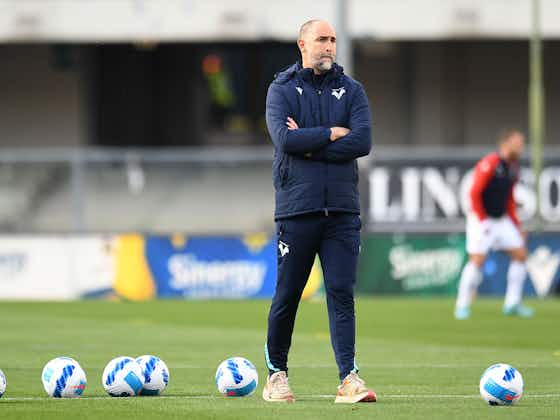
In partnership with
Yahoo sportsThe Laziali
·16 March 2024

When Simone Inzaghi left Lazio to join Inter, President Claudio Lotito had a rather difficult task of naming a replacement, especially since cross-town rivals got a big name in the form of Jose Mourinho.
In the end, Lazio made the appointment of Maurizio Sarri who was famous for his attractive style of play and had won the Scudetto with Juventus and Europa League with Chelsea.
Two seasons later Sarri has pre-maturely ended his tenure at Lazio following their four consecutive losses between Serie A and Champions League, and being in 9th place; far away from European competition spots.
Igor Tudor is set to be announced for the vacant Lazio spot. With the appointment of Sarri, there was a tectonic shift from Inzaghi’s 3-5-2 to Sarri’s proactive 4-3-3 formation.
Inzaghi was at Lazio from 2016 till the end of the 2020-21 season making Lazio a stronghold with their 3-5-2 system getting the best out of players like Ciro Immobile, Francesco Acerbi, Sergej Milinkovic-Savic, Luis Alberto and Manuel Lazzari. With the appointment of Sarri, they had moved on from 3-5-2 but with Tudor’s appointment, Lazio may go back to a familiar formation.
Tudor is most famously known for his work in Serie A with Hellas Verona. Taking over from Eusebio Di Francesco, who had lost his first four games in charge, Tudor shifted back to a 3-4-2-1 and had Verona play aggressive European-style football whilst achieving results. Guiding the team to 9th place in the table in the 2021-22 season, Tudor left Verona citing disagreement with owners; the same Summer saw an exodus at Verona with the club selling virtually their three main forwards due to financial issues.
Following this, he took up a job at Olympique Marseille and while playing exhilarating football once again he guided the team to third place (Champions League play-off spot) and left the same season once again citing disagreement with the owners who were having many off-field issues. Since then, Tudor has been out of a job and was linked to the vacant Napoli job when Rudi Garcia was linked. Now with Lazio, he has a team with ample resources and the necessary backing to achieve results.
With this article, we attempt to take a look at the tactics he deployed at Verona and what Lazio fans can expect.
It is important to note that Verona used a 3-4-2-1 system with three at the back, two wing-backs, a double pivot, two number 10s, and a striker. But when Verona had the ball (as seen below) they metamorphized into a 3-2-5 shape. Their ideas in possession were clear – play the ball vertically before the opposition’s defence got organized and closed the gaps.
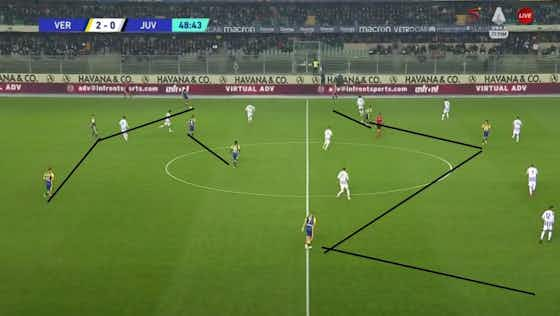
Usually when Verona built up from the back, they used a 3+2 system where the wing-backs split to keep the width while the double pivot acted as the passing options, as seen below.
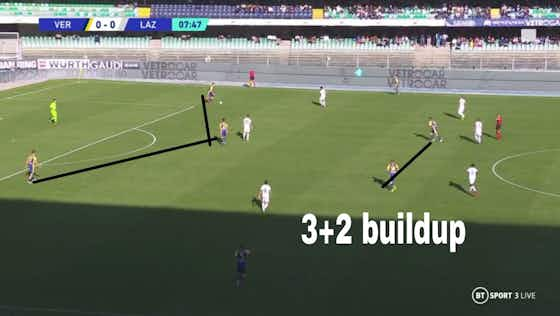
The double pivot, meanwhile, was tasked to mainly protect the back three. But while Verona were on the ball, the pivot player on the far side (as seen below) would try to switch play to the winger on the far side.
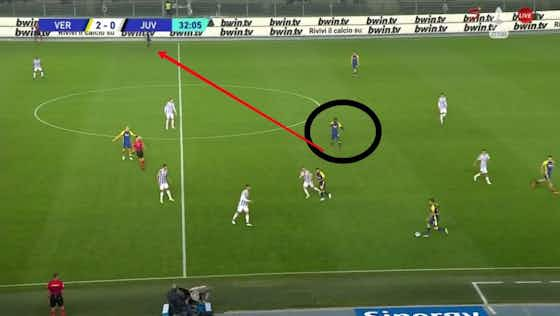
The front three were tasked with carrying out the attack. The two number 10s (Caprari and Barak) played between the second line and last line of defence.
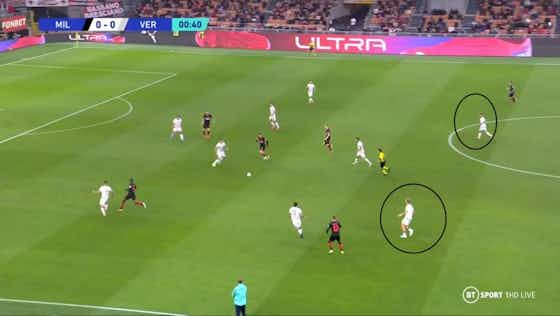
They usually received the ball with their backs to the goal. If they were allowed to turn then they would try to find Simeone with diagonal through balls behind the defence.
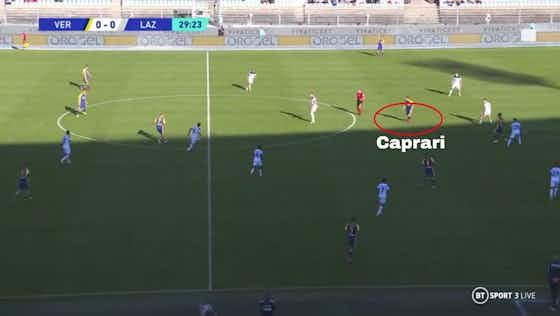

While Simeone played off of the shoulder of the last defender, he kept on the last line of defence to reduce the gap between defence and midfield, and therefore not give gaps for Caprari and Barak. While in the opposition half, Caprari and Barak kept a distance of only 6-10 meters between them which allowed for quick one-twos, displacing defenders from their positions. In addition, to pull defenders out of position and to beat their markers, sometimes Barak would drop into the double pivot position while Ilic pushed up.
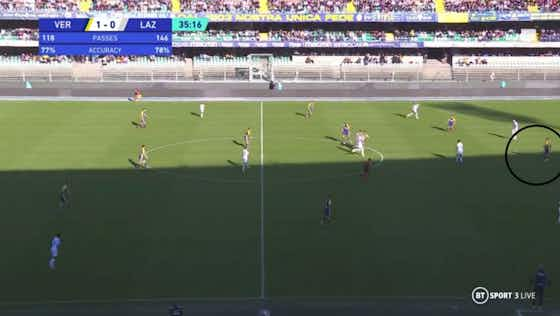
The main source of width in the system was the wing-backs who played near the touchline. Against teams who liked to play narrow, the wide wing-backs would make them either stretch their defence and create space in the center or the wing-backs would have a free reign to cross the ball into the center. They would usually overlap – and sometimes even underlap – the 10s when they wandered to the wide areas. Although Verona liked to build through the center, they sprayed the ball wide for crosses into the box.
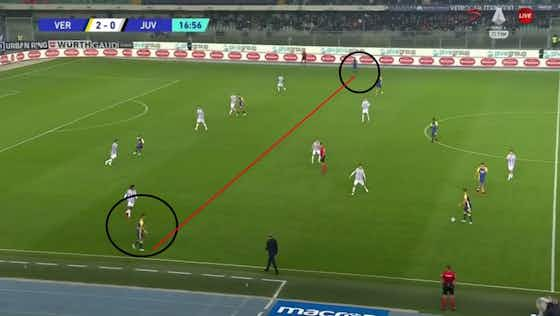
Tudor uses an aggressive man-oriented pressing scheme against Sarri’s more ball-oriented approach with a conservative approach. The shape of the pressing structure was defined by the opposition’s movements. They liked to press very high up the pitch alluding to a more European style of play rather than classical Italian style.
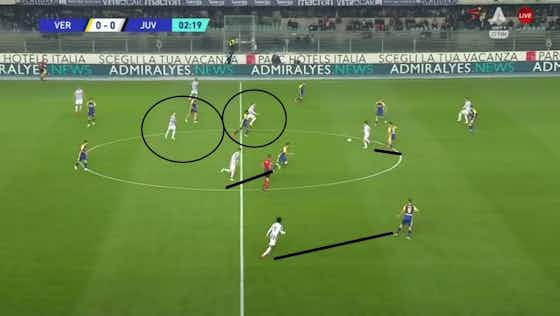
They also often created pressing traps for the opponent. As you can see in the picture below, Lazio were aiming to restart play from a goal kick by playing out from the back and Verona had gone man-to-man in the pressing scheme. However, they did not press Lazio left-back Hysaj, and this is a clear trap to direct Lazio to play to Hysaj, who would then be aggressively pressed by Faraoni. Sure enough, although Lazio didn’t take the bait initially when they were suffocated by the press, they tried passing to Hysaj but it was usually intercepted which resulted in a quick counter.
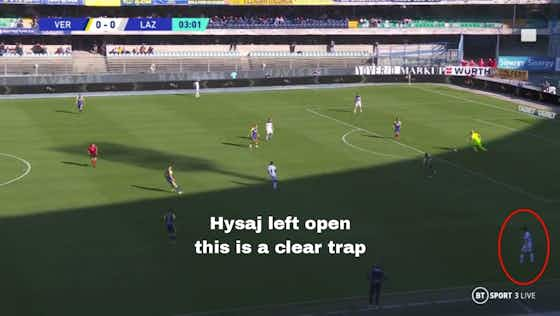
Verona also used a very aggressive counter-press (pressing to win back the ball immediately after losing possession) but if the opposition played out of it, they would sit back in their off-the-ball formation. In the 2021-22 season, Verona had the second-highest PPDA (Passes Per Defensive Action) in the league, which is a metric used to consider how effective the press of a team is on the opposition.
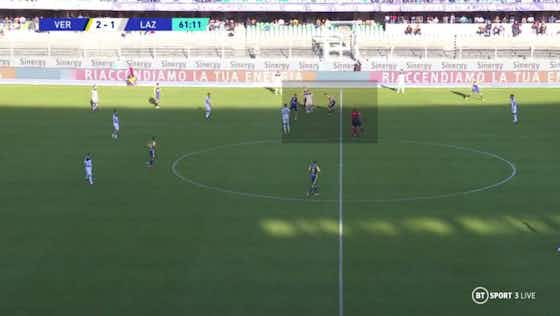
Like all high-pressing teams, Verona used a high line to reduce the space between the first line of defence and the last line and reduce the gaps for the opposition to exploit. They used a 5-4-1 off-the-ball structure to restrict the attack of opponents.
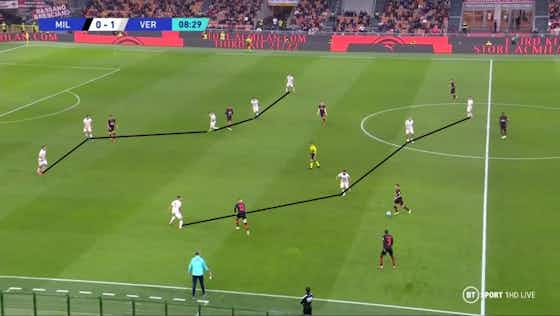
With a mid-season appointment, it might take a while and maybe the summer window for Lazio to make the required adjustments moving from Sarriball to Tudor’s high-energy style of play.
Tudor is known for his very hands-on and rather no-nonsense approach with the players; an anecdote of his issues with cult hero Dimitri Payet at Marseille is rather emblematic of his approach. Payet often turned up late for training with no respect for Tudor’s instructions. This often led to clashes and the Manager leaving him out of the main team, which showed his rather intolerant and unbiased view of players.
In terms of compatibility, one can’t stop wondering if this might bring back Daichi Kamada in contention for being a starter as he was employed as a no.10 in a 3-4-2-1 in a similar system by then Frankfurt coach Olivier Glasner.
The wing-back role might also see the likes of Marusic and Lazzari perform better as they did their best in the wing-back role under Inzaghi. The same can be said for Luis Alberto and Zaccagni who were at the best in back three formations under Inzaghi and Juric respectively.
With almost all details seeming to have been ironed out, it needs to be seen how Lazio move on from Sarri to a more modern coach like Tudor.
This Article Was Written by Tactics Expert Rohit Rajeev (@keralista on Twitter)


Live





























































